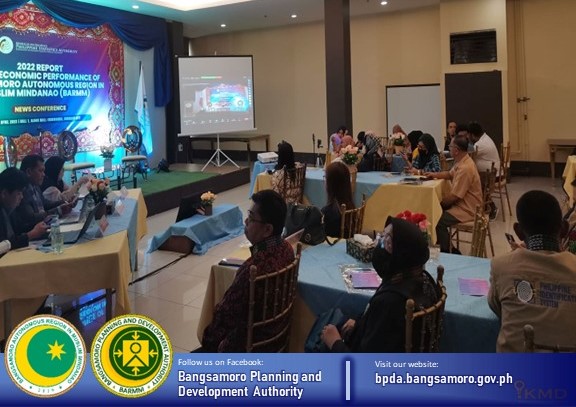
COTABATO CITY – The Bangsamoro Autonomous Region in Muslim Mindanao (BARMM) recorded the tenth-fastest economic growth among all regions in the country, with its economic performance grew by 6.6% in 2022, slower than 7.5% growth rate in 2021. This result is announced by the Philippine Statistics Authority (PSA-BARMM) through a news conference held today, April 27, 2023.
Melanie M. Indar, Director for Planning and Policies Bureau of the Bangsamoro Planning and Development Authority (BPDA), took part as a discussant in the said event and as a representative of BPDA Director General Engr. Mohajirin T. Ali, who is also the chairperson of the Regional Statistics Committee (RSCom) under the Bangsamoro Economic and Development Council (BEDC).
In her message, Dir. Indar underscored that setting a record as the tenth fastest-growing region in the Philippines is a remarkable achievement and a testament to the region’s resilience and hard work.
“Although the growth rate has slowed down, we believe that BARMM’s economy is still on track for robust growth,” she stressed.
She also said that as the Bangsamoro government sets its goal for the BARMM as reflected in the 2nd Bangsamoro Development Plan (BDP) 2023-2028, it is committed to achieve its macroeconomic targets for 2023-2028, sustain an average annual growth rate of 6-9% within six years, and create more opportunities for the people of the BARMM.
“We need to continue promoting investment and trade, enhancing the region’s infrastructure, and supporting the development of human capital through education and training,” she added.
During his report on BARMM’s economic performance, PSA-BARMM OIC Regional Director Engr. Akan G. Tula revealed that in 2022, BARMM’s per capita GRDP/GRDE was estimated at 56,970 pesos, increased by 4.5% from the previous year’s record of 54,528 pesos.
The Household Final Consumption Expenditure (HFCE) has the highest share of expenditure items to the regional economy of BARMM with 110.6%, followed by Government Final Consumption Expenditure (GFCE) with 36.7%, Gross Capital Formation with 19.4%, Net Exports to the Rest of the World with -3.2%, and Net Exports to the Rest of the Philippines at -63.5%. Further, the per capita HFCE of BARMM in 2022 was estimated at 63,033 pesos, increased by 4.0% from the previous year’s record of 60,581 pesos.
Accordingly, BARMM is predominantly Services-based with 40.1% share, followed by Agriculture, Forestry and Fishing at 35.4% share, and Industry with 24.5% share.
“It is the desire of the government of the day to venture into agricultural and fishery development, expand the industry and service sectors in all parts of the region,” said BARMM Chief Minister Ahod B. Ebrahim.
CM Ebrahim also shared that with the projected rapid growth of the working-age population, the Bangsamoro government would further invest in construction, real estate, trade, tourism, and investment as sunrise industries, as it envisions of becoming a tourist, trade, and investment hub in the BIMP-EAGA region.
In a message delivered by Florande S. Polistico, Chief Statistical Specialist from PSA Central Office, PSA Undersecretary and National Statistician Dennis S. Mapa said that the agency’s goal for the GRDP and GRDE is to provide the policymakers and stakeholders with a comprehensive picture of the regional economies, which will serve as an important tool for planning and policy formulation at the regional level.
“GRDP and the GRDE are major economic indicators that will bring change in the lives of our countrymen through its impact from results of plans and policies that might be crafted using these indicators,” he said.
According to PSA, GRDP or Gross Regional Domestic Product is “the aggregate of gross value added (GVA) of all resident producer units in the region,” while GRDE or Gross Regional Domestic Expenditure is defined as “the expenditure of residents of the region in the domestic territory plus their expenditures in other regions including the rest of the world.”
The PSA Regional Statistical Services Offices spearheaded a news conference for simultaneous release of result on the ‘2022 Regional Accounts of the Philippines’ in all 17 regions in the country. (𝑀𝑎𝑟𝑦 𝐿𝑜𝑣𝑒𝑙𝑙𝑎 𝐿𝑎𝑜-𝐿𝑎𝑠𝑡𝑖𝑚𝑜𝑠𝑎, 𝐼𝐾𝑀𝐷, 𝐵𝑃𝐷𝐴-𝐵𝐴𝑅𝑀𝑀)



